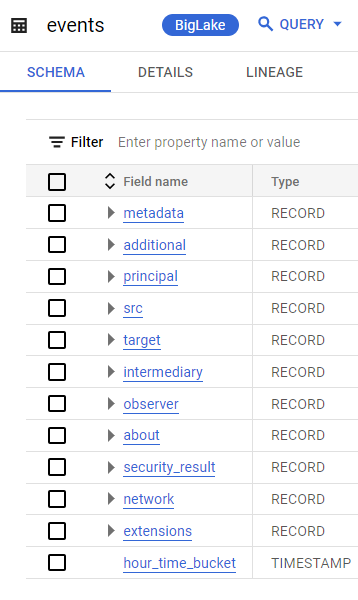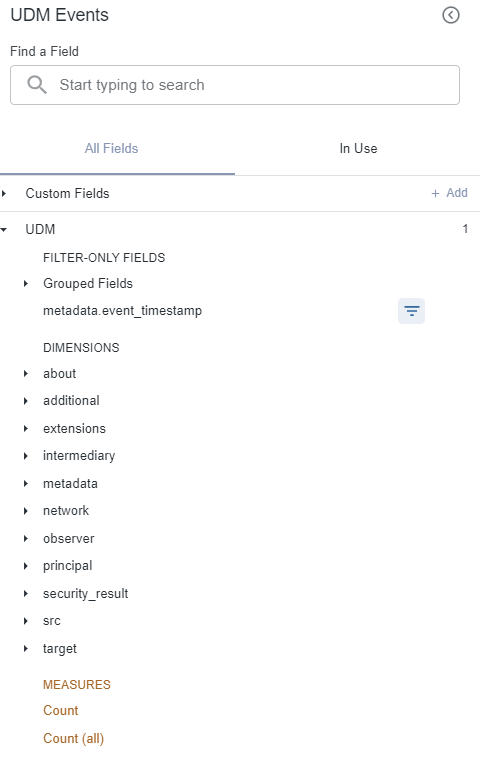Google SecOps 事件架构
在 BigQuery 中,名为 events 的表存储 UDM 事件记录。
hour_time_bucket 字段将分区标识为 metadata.event_timestamp UDM 字段中的小时。hour_time_bucket 字段中的值是每小时的时间戳,格式为:<YYYY-MM-DD HH:MM:SS UTC>。下面是一些示例:
- 2022-05-20 00:00:00 UTC
- 2022-05-20 01:00:00 UTC
- 2022-05-20 02:00:00 UTC
- 2022-05-20 03:00:00 UTC
例如,值 2022-05-20 00:00:00 UTC 会将 event_timestamp 介于 2022-05-20 00:00:00 UTC 和 2022-05-20 00:59:59 UTC 之间的数据标记为有效。如需了解详情,请参阅查询分区表。
数据显示在 events 表格中所需的时间取决于设备记录事件的时间 (metadata.event_timestamp) 与该事件提取到 Google Security Operations SIEM 的时间 (metadata.ingested_timestamp) 之间的差异。
下表总结了数据在 Google Security Operations 收到后显示在 events 表中所需的时间:
- 如果差异不到 2 小时,则数据会在大约 2 小时后显示。
- 如果差异介于 2 小时到 24 小时之间,数据在提取后最长可能需要 4 小时才会显示。
- 如果差异超过 24 小时,数据在提取后最长可能需要 5 天才能显示。
events 表架构会定期更改。如需查看表的相关信息(包括当前架构),请参阅 BigQuery 中的获取表信息说明。
如需访问 events 架构,请执行以下操作:
- 打开 Google Cloud 控制台,然后选择 Google SecOps 代表提供给您的 Google SecOps 项目 ID。
依次选择 BigQuery > BigQuery Studio > datalake > events。

图:BigQuery 中的
events表
信息中心的 Events 数据模型
在 Google SecOps 嵌入式信息中心内,您会看到一个名为 UDM 事件的数据结构。这是为 BigQuery 中的 events 表创建的 Looker 数据模型。
下表包含最常用的 UDM 字段。其中不包含所有 UDM 字段。如果您需要将某些 UDM 字段纳入到个性化信息中心,但这些字段缺失,请与您的 Google SecOps 代表联系。
如需查看此探索中的字段,请执行以下步骤:
- 在导航栏中,点击信息中心。
- 创建新信息中心(依次点击添加 > 新建),或修改现有信息中心。
- 添加功能块。
- 如果系统提示,请选择可视化图表作为类型。
- 在表格列表中,选择 UDM 事件。
浏览字段列表。

图:Google SecOps 事件数据模型中的字段列表
后续步骤
- 如需查看每个 UDM 字段的说明,请参阅统一数据模型字段列表。
- 如需了解如何在 BigQuery 中访问和运行查询,请参阅运行交互式查询作业和批量查询作业。
- 如需了解如何查询分区表,请参阅查询分区表。
- 如需了解如何将 Looker 连接到 BigQuery,请参阅有关连接到 BigQuery 的 Looker 文档。
- 有关如何查询分区表的信息。

